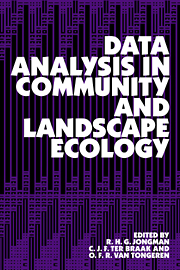Book contents
6 - Cluster analysis
Published online by Cambridge University Press: 11 October 2009
Summary
Introduction
Aims and use
For ecological data, cluster analysis is a type of analysis that classifies sites, species or variables. Classification is intrinsic in observation: people observe objects or phenomena, compare them with other, earlier, observations and then assign them a name. Therefore one of the major methods used since the start of the study of ecology is the rearrangement of data tables of species by sites, followed by the definition of community types, each characterized by its characteristic species combination (Westhoff & van der Maarel 1978; Becking 1957). Scientists of different schools have different ideas about the characterization of community types and the borders between these types. In vegetation science, for instance, the Scandinavian school and the Zürich–Montpellier school differ markedly, the Scandinavians emphasizing the dominants and the Zürich–Montpellier school giving more weight to characteristic and differential species, which are supposed to have a narrower ecological amplitude and are therefore better indicators for the environment. Cluster analysis is an explicit way of identifying groups in raw data and helps us to find structure in the data. However even if there is a continuous structure in the data, cluster analysis may impose a group structure: a continuum is then arbitrarily partitioned into a discontinuous system of types or classes.
Aims of classification are:
– to give information on the concurrence of species (internal data structure)
– to establish community types for descriptive studies (syntaxonomy and mapping)
- Type
- Chapter
- Information
- Data Analysis in Community and Landscape Ecology , pp. 174 - 212Publisher: Cambridge University PressPrint publication year: 1995
- 61
- Cited by



